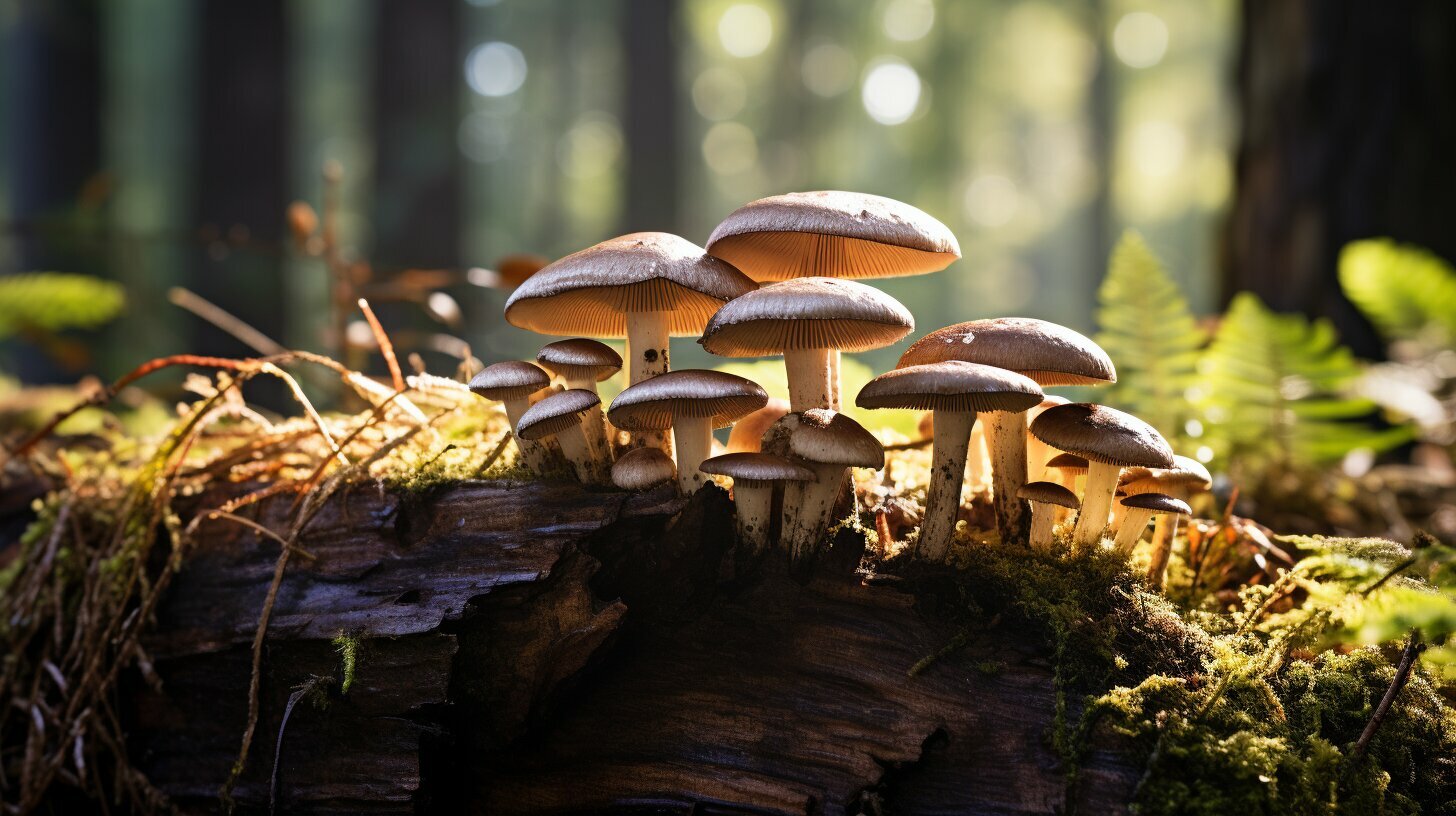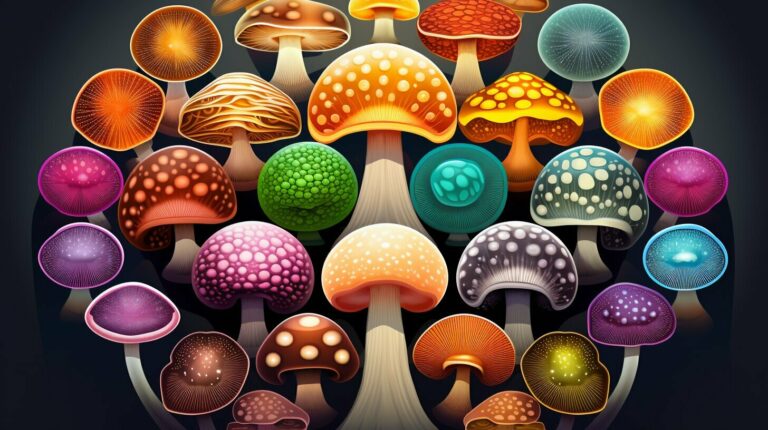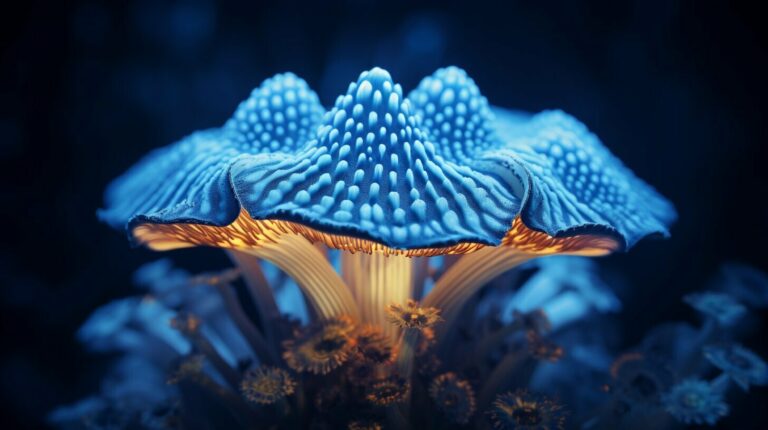Growing gourmet and medicinal mushrooms at home can be a rewarding and fulfilling experience, providing both health benefits and exciting culinary opportunities. Cultivating these unique fungi in your own space allows you to have a direct hand in their growth and harvest, ensuring freshness and quality for your consumption.
- Home cultivation of gourmet and medicinal mushrooms offers numerous health benefits and culinary adventures.
- The comprehensive guide “Growing Gourmet & Medicinal Mushrooms” by Paul Stamets covers all aspects of mushroom cultivation.
- Precise growth parameters for thirty-one mushroom species are provided in the book, ensuring successful cultivation.
- Gardening tips, state-of-the-art production techniques, and advice for laboratory and growing room construction are included.
- Delicious mushroom recipes and expert insights from Paul Stamets and Fungi Perfecti enhance the cultivation journey.
The Comprehensive Guide: “Growing Gourmet & Medicinal Mushrooms” by Paul Stamets
Table of Contents
“Growing Gourmet & Medicinal Mushrooms” by Paul Stamets is an invaluable resource for anyone interested in cultivating and utilizing a wide range of gourmet and medicinal mushrooms. This comprehensive guide covers everything from precise growth parameters for thirty-one mushroom species to gardening tips, state-of-the-art production techniques, and advice for laboratory and growing room construction. With over 500 photographs, illustrations, and charts, this book provides a visually engaging experience that helps readers identify each stage of cultivation.
Paul Stamets, a leading expert in mycology and the founder of Fungi Perfecti, brings his extensive knowledge and experience to this book. As a sought-after lecturer and author of two mycology textbooks, Stamets is renowned for his expertise in the field. “Growing Gourmet & Medicinal Mushrooms” showcases his passion for mushrooms and his dedication to sharing his insights with others.
“The cultivation of gourmet and medicinal mushrooms has the potential to revolutionize our health and well-being while offering endless culinary possibilities,” says Stamets. “This book aims to empower readers to embark on their own mushroom cultivation journey and discover the incredible benefits that these fungi can bring.”
Whether you’re a beginner or a seasoned mushroom cultivator, this guide offers valuable advice and practical tips to ensure successful cultivation. From troubleshooting common challenges to exploring mushroom recipes and culinary delights, Stamets covers every aspect of mushroom cultivation with clarity and expertise. With the guidance provided in “Growing Gourmet & Medicinal Mushrooms,” you’ll be well-equipped to embark on an exciting journey into the world of mushrooms.
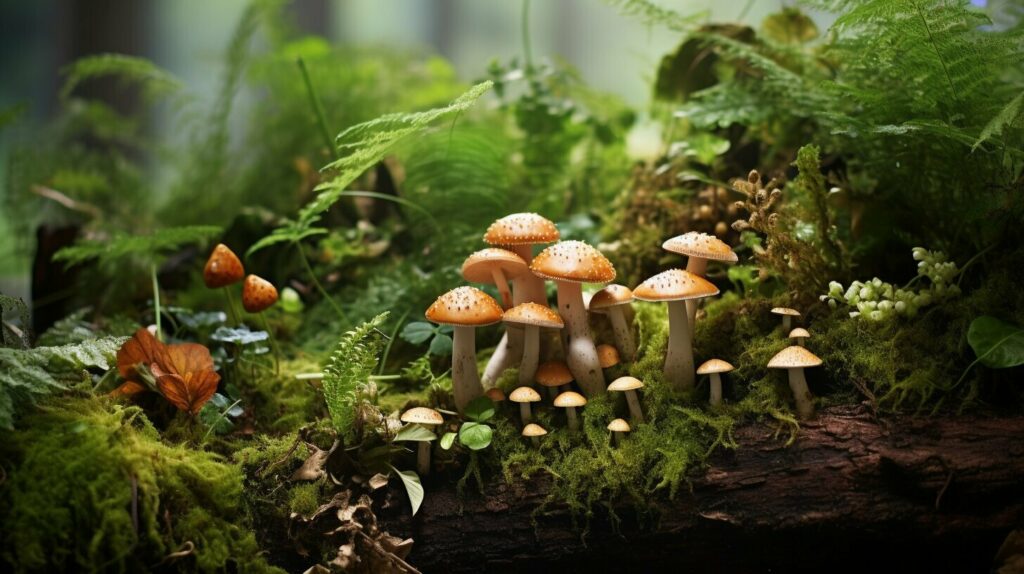
| Mushroom Species | Optimal Temperature (°F) | Relative Humidity (%) | Lighting Requirements |
|---|---|---|---|
| Agaricus bisporus | 55-65 | 85-95 | Low light |
| Ganoderma lucidum | 75-85 | 80-90 | Partial shade |
| Pleurotus ostreatus | 60-70 | 85-95 | Low to moderate light |
| … | … | … | … |
Precise Growth Parameters for 31 Mushroom Species
Understanding the precise growth parameters for each mushroom species is crucial for successful cultivation and maximizing their potential. The book “Growing Gourmet & Medicinal Mushrooms” by Paul Stamets provides detailed information on the specific requirements of thirty-one mushroom species, ensuring cultivators have the necessary knowledge to create optimal growing conditions.
One of the key aspects covered in the book is the temperature range suitable for each species. For example, Shiitake mushrooms thrive between 55 and 65 degrees Fahrenheit, while Lion’s Mane mushrooms prefer a slightly cooler environment of 45 to 55 degrees Fahrenheit. By maintaining the correct temperature, growers can ensure the mushrooms grow healthily and produce high-quality yields.
In addition to temperature, the book also delves into other crucial growth parameters such as humidity levels, light exposure, and substrate composition. Each species has specific requirements in these areas, and understanding and implementing them correctly can greatly increase the success rate of cultivation.
“The parameters provided in this book have been meticulously researched and tested, offering growers a comprehensive guide to successful mushroom cultivation,” says Paul Stamets, the author of “Growing Gourmet & Medicinal Mushrooms.” “By understanding and meeting the precise growth requirements, cultivators can unlock the full potential of these fascinating organisms.”
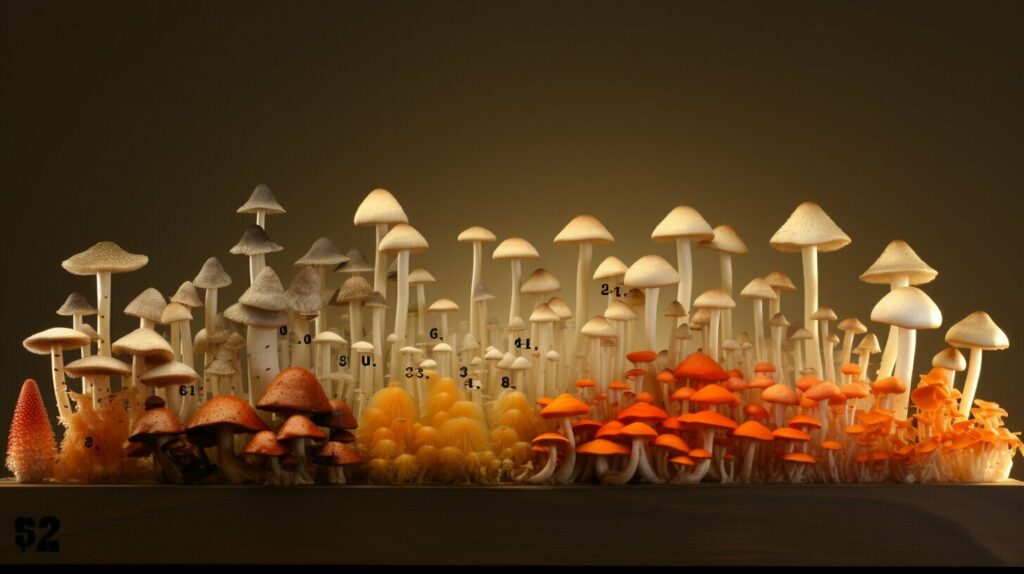
| Mushroom Species | Temperature Range (°F) | Humidity Range (%) | Light Exposure | Substrate Composition |
|---|---|---|---|---|
| Shiitake | 55-65 | 80-90 | Indirect sunlight | Sawdust, straw, or logs |
| Lion’s Mane | 45-55 | 85-95 | Low to medium light | Sawdust, wood chips, or grain |
By following the precise growth parameters outlined in “Growing Gourmet & Medicinal Mushrooms,” cultivators can create the ideal conditions for each mushroom species, leading to successful cultivation and an abundant harvest.
Gardening Tips for Mushroom Cultivation
Cultivating mushrooms requires specific gardening techniques that can greatly improve your chances of success and yield. Whether you’re a seasoned gardener or a beginner, these tips will help you create the perfect environment for growing your own gourmet and medicinal mushrooms.
Choose the right substrate
The substrate is the material on which mushrooms grow. Different mushroom species have different substrate preferences, so it’s important to choose the right one for the mushrooms you want to cultivate. Common substrates include straw, sawdust, wood chips, and compost. Make sure the substrate is clean and free from contaminants before starting the cultivation process.
| Mushroom Species | Recommended Substrate |
|---|---|
| Shiitake | Hardwood logs or sawdust |
| Oyster | Pasturized straw or coffee grounds |
| Lion’s Mane | Hardwood chips or sawdust |
Maintain proper moisture levels
Mushrooms thrive in a moist environment, but excessive moisture can lead to contamination and mold growth. It’s important to strike the right balance. Regularly mist your growing area to maintain humidity, and monitor the moisture level of the substrate. If it feels too dry, lightly spray it with water. On the other hand, if it feels too wet, increase ventilation to prevent excess moisture buildup.
Provide adequate ventilation and fresh air
Mushrooms not only need moisture but also require fresh air to grow properly. Proper ventilation helps prevent the buildup of carbon dioxide and promotes healthy mycelium growth. Provide fresh air by opening windows or using fans to circulate the air in your growing area. Avoid stagnant air, as it can create conditions favorable for contamination.
By following these gardening tips, you’ll be well on your way to successful mushroom cultivation. Remember to be patient and attentive to the needs of your mushrooms, and soon you’ll be enjoying the fruits of your labor in the form of delicious, homegrown mushrooms.
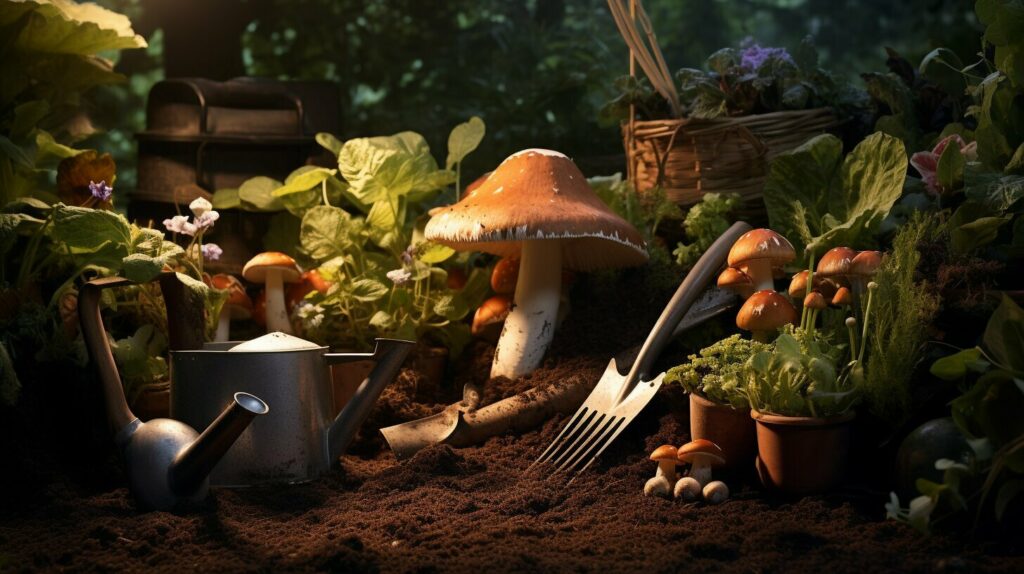
Discover the cutting-edge production techniques that can elevate your mushroom cultivation to new heights. Embracing state-of-the-art methods can significantly enhance both productivity and quality, allowing you to cultivate gourmet and medicinal mushrooms like never before.
One advanced technique gaining popularity is the use of controlled environment agriculture (CEA). This method involves creating an optimal growing environment by controlling variables such as temperature, humidity, light, and airflow. CEA systems, such as climate-controlled grow rooms or greenhouses, enable growers to cultivate mushrooms year-round, regardless of external conditions.
Another innovative method is the incorporation of vertical farming. By utilizing vertical space efficiently, growers can maximize their production capacity. Vertical farming systems use stacked trays or racks to create multiple growing levels, increasing the yield per square foot of space. This approach is particularly beneficial for urban mushroom farms or limited growing areas.
“The combination of CEA and vertical farming has revolutionized the mushroom cultivation industry. It allows for precise control over growing conditions and maximizes production potential.”
– Paul Stamets, Growing Gourmet & Medicinal Mushrooms–
Furthermore, advanced substrate preparation techniques have proven to be a game-changer in mushroom cultivation. Novel methods, such as steam sterilization and pasteurization, ensure the substrates are free from contaminants and provide an ideal environment for fungal growth. By optimizing substrate composition and moisture content, growers can achieve faster colonization and higher yields.
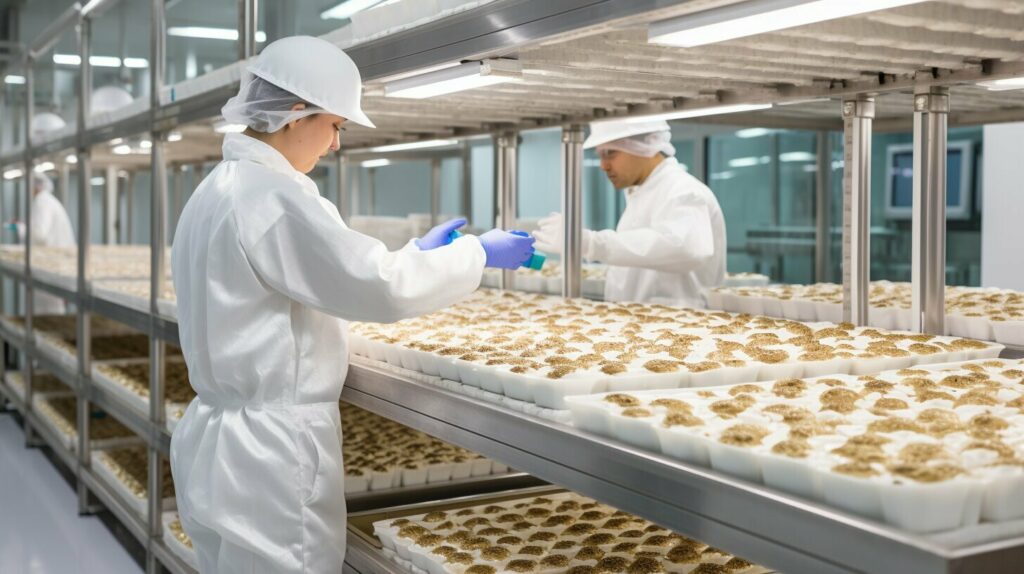
| Technique | Description |
|---|---|
| Spawn Run Optimization | Controlling environmental factors, such as temperature and oxygen levels, during the spawn run to promote healthy mycelium growth and shorten colonization time. |
| Bioreactors | Using specialized vessels to cultivate mushrooms in a controlled, sterile environment. Bioreactors offer precise control over nutrients, humidity, and airflow, resulting in consistent yields. |
| Alternative Substrates | Exploring the use of unconventional substrates, such as agricultural waste or synthetic materials, to diversify mushroom cultivation and reduce environmental impact. |
By embracing these state-of-the-art production techniques and continually staying informed about the latest advancements, mushroom cultivators can unlock the full potential of their fungi. With improved control over growth conditions, increased productivity, and enhanced quality, you can take your mushroom cultivation journey to new heights.
Advice for Laboratory and Growing Room Construction
Building a well-designed laboratory and growing room is crucial for maintaining optimal conditions and ensuring the success of your mushroom cultivation endeavors. The infrastructure plays a significant role in creating the ideal environment for mushroom growth, which includes temperature control, adequate ventilation, and proper lighting.
When constructing your laboratory, focus on insulation to regulate temperature fluctuations and reduce energy consumption. Double-pane windows and well-insulated walls can help maintain a consistent temperature, preventing unwanted heat loss or gain. Additionally, consider installing an HVAC system with a temperature and humidity controller to create the perfect climate for your mushroom cultivation.
For your growing room, it’s important to have proper airflow and ventilation. This can be achieved by installing fans or air filtration systems to ensure sufficient air exchange and prevent the buildup of carbon dioxide. Additionally, consider incorporating a dehumidifier to maintain the ideal humidity levels for your mushroom species. Remember to monitor and adjust the ventilation and humidity levels regularly to provide the best conditions for your mushrooms.
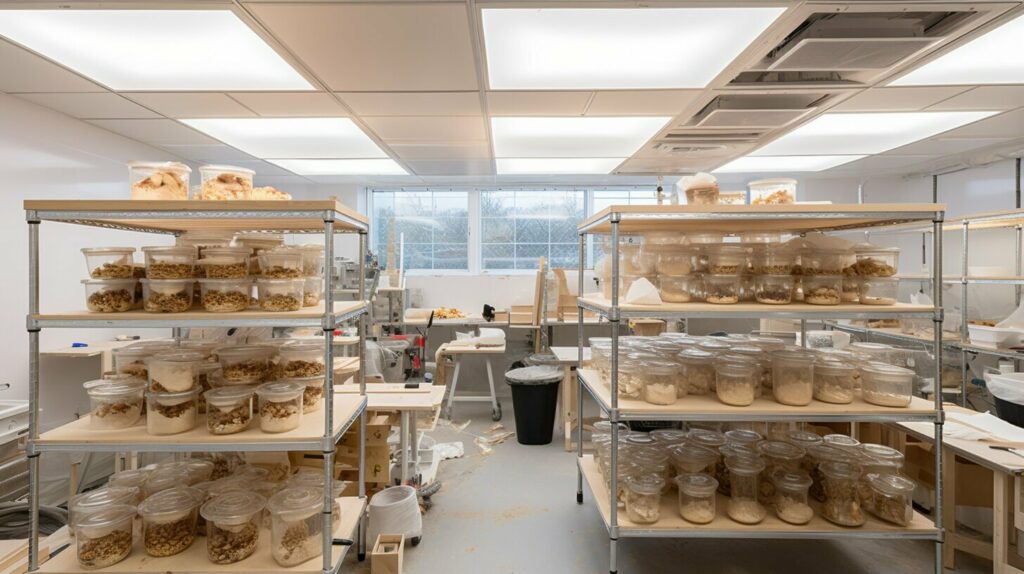
Lighting is another essential aspect of lab and growing room construction. Some mushroom species require specific lighting conditions to stimulate growth. Consider using full-spectrum LED lights or fluorescent lights to mimic natural sunlight and provide the necessary light spectrum for your mushrooms’ development.
| Infrastructure Considerations: | Construction Tips: |
|---|---|
| Insulation | Focus on insulation to regulate temperature fluctuations and reduce energy consumption. |
| Ventilation | Install fans or air filtration systems for proper airflow and ventilation. |
| Humidity Control | Consider incorporating a dehumidifier to maintain the ideal humidity levels for your mushrooms. |
| Lighting | Use full-spectrum LED or fluorescent lights to simulate natural sunlight. |
By paying attention to these essential factors during laboratory and growing room construction, you can create an environment that promotes healthy mushroom growth and increases your chances of a successful harvest. Remember to consult resources like “Growing Gourmet & Medicinal Mushrooms” by Paul Stamets for more detailed guidance on laboratory construction and mushroom cultivation techniques.
Mushroom Recipes and Culinary Delights
Get ready to unleash your creativity in the kitchen with an array of mouthwatering mushroom recipes and experience the unique flavors they bring to your culinary creations. Gourmet mushrooms offer a tantalizing range of tastes and textures that can elevate any dish to new heights. Whether you’re a seasoned chef or a passionate home cook, exploring the world of mushroom recipes will open up a world of possibilities for your taste buds.
From creamy mushroom risottos to hearty mushroom stews, there’s a recipe for every palate. Impress your guests with a stunning mushroom tart, or indulge in a decadent mushroom and truffle pasta. The umami-rich flavors of mushrooms add depth and complexity to vegetarian dishes, while their meaty texture makes them the perfect ingredient for satisfying mushroom burgers or stuffed mushrooms. With the right techniques and ingredients, you can create delectable appetizers, main courses, and even desserts featuring these versatile fungi.
But don’t limit yourself to tried-and-true recipes. Let your imagination run wild and experiment with bold flavor combinations. Create a savory mushroom and blue cheese omelet for a luxurious breakfast, or spice things up with a fiery mushroom curry. The possibilities are endless, and your taste buds will thank you for the culinary adventure.
Sample Mushroom Recipes:
| Recipe | Description |
|---|---|
| Mushroom Risotto | A creamy and comforting Italian rice dish infused with the earthy flavors of mushrooms. |
| Portobello Mushroom Burger | A juicy and flavorful vegetarian burger with a meaty portobello mushroom cap as the star ingredient. |
| Mushroom and Spinach Stuffed Chicken | Tender chicken breasts filled with a savory mixture of mushrooms, spinach, and cheese for a gourmet twist on a classic. |
| Wild Mushroom Soup | A velvety soup bursting with the rich and earthy flavors of a variety of wild mushrooms. |
Explore the world of gourmet mushrooms and let their unique flavors inspire your culinary adventures. With the help of the comprehensive guide “Growing Gourmet & Medicinal Mushrooms” by Paul Stamets, you’ll have all the information and techniques you need to cultivate your own mushrooms and create sensational dishes. So, grab your apron, sharpen your knives, and get ready to embark on a truly delicious journey.
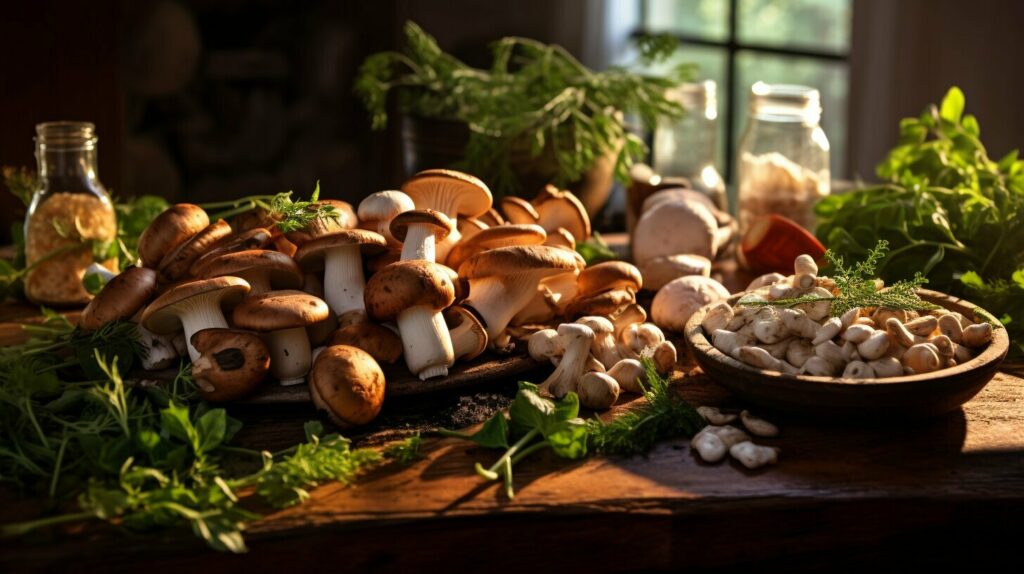
Don’t let setbacks discourage you – equip yourself with a comprehensive troubleshooting guide to tackle common obstacles in mushroom cultivation. As with any gardening endeavor, mushroom cultivation can sometimes present challenges along the way. However, armed with the right knowledge and solutions, you can overcome these hurdles and continue to enjoy a successful harvest.
One common problem that cultivators encounter is contamination. This can occur when unwanted fungi, bacteria, or molds infiltrate the growing environment, competing with the desired mushroom species. To mitigate this issue, it is crucial to maintain a clean and sterile growing environment. Regularly sanitize your tools, containers, and growing spaces, and be mindful of the quality of your substrate and spawn. By practicing good hygiene and using high-quality materials, you can minimize the risk of contamination.
Another challenge is achieving optimal moisture levels. Mushrooms thrive in specific humidity ranges, and deviations can affect their growth and development. To address this issue, carefully monitor and maintain humidity levels using methods such as misting, fogging, or utilizing a humidifier. Additionally, avoid overwatering, as excessive moisture can lead to fungal diseases. Finding the right balance of moisture is essential for ensuring healthy mushroom growth.
| Common Problems | Solutions |
|---|---|
| Contamination | Regularly sanitize tools and growing spaces, use high-quality materials |
| Moisture levels | Monitor and maintain humidity levels, avoid overwatering |
| Poor mushroom formation | Ensure proper air circulation and lighting, adjust temperature if necessary |
Remember, mushroom cultivation is a journey of learning and experimentation. Don’t be discouraged by setbacks – they are opportunities to refine your techniques and deepen your understanding of the fascinating world of fungi.
If you are facing issues with poor mushroom formation, consider factors such as air circulation, lighting, and temperature. Mushrooms need adequate airflow to develop properly, so ensure that your growing space has proper ventilation. Additionally, assess the lighting conditions and adjust as needed, as inadequate or excessive light can affect mushroom formation. Finally, monitor and maintain the appropriate temperature range for your specific mushroom species, as temperature fluctuations can impact their growth.
By equipping yourself with this troubleshooting guide and adopting a proactive approach, you can navigate the challenges that may arise during mushroom cultivation. Remember to consult additional resources, such as the book “Growing Gourmet & Medicinal Mushrooms” by Paul Stamets, for detailed insights and expert advice.
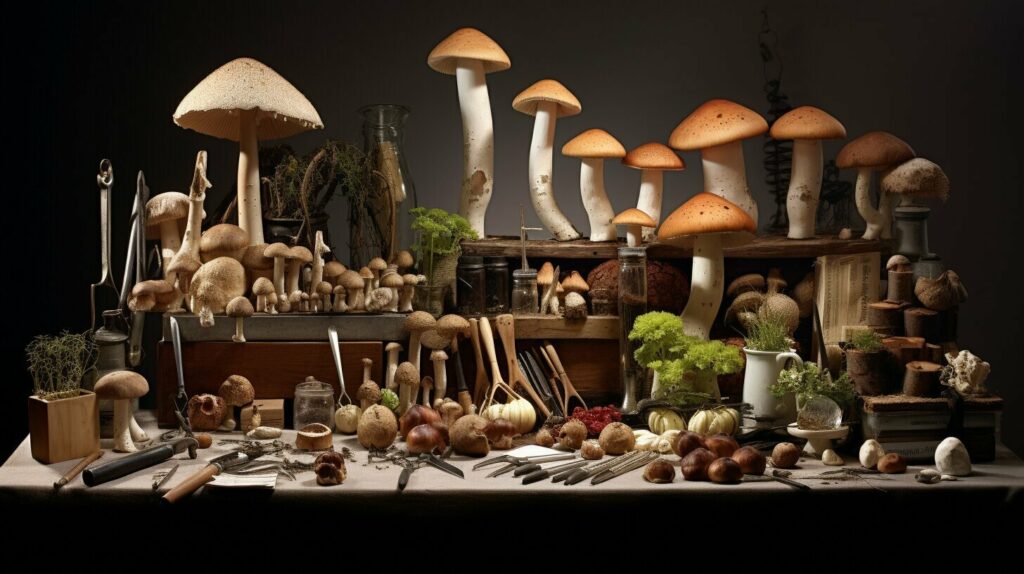
- Keep a detailed cultivation log to track your progress, including dates, environmental conditions, and any issues encountered.
- Experiment with different mushroom species and cultivation techniques to expand your knowledge and skills.
- Engage in online forums or local mushroom cultivation communities to seek guidance and learn from experienced cultivators.
Remember, successful mushroom cultivation requires patience, attention to detail, and a willingness to learn from both successes and setbacks. Embrace the challenges and enjoy the rewarding experience of nurturing these remarkable organisms.
Expert Insight from Paul Stamets and Fungi Perfecti
Benefit from the wisdom and experience of acclaimed mycologist Paul Stamets and the expertise of Fungi Perfecti, a renowned organization in the field of mushroom cultivation. With their comprehensive guide, “Growing Gourmet & Medicinal Mushrooms,” you can delve into the fascinating world of mushrooms and unlock the secrets of successful cultivation.
Stamets, a leading expert in mycology, has dedicated his life to studying and understanding fungi. He has published two mycology textbooks and is a sought-after lecturer on the subject. His passion for mushrooms is evident in the meticulously researched information provided in his book, making it an essential resource for both beginners and experienced cultivators.
“Mycelium is the neurological network of nature. Interlacing mosaics of mycelium infuse habitats with information-sharing membranes. These membranes are aware, react to change, and collectively have the long-term health of the host environment in mind.”
The book offers precise growth parameters for thirty-one mushroom species, ensuring you have the knowledge to cultivate a wide range of gourmet and medicinal varieties. Whether you are interested in the earthy flavors of oyster mushrooms or the immune-boosting properties of reishi mushrooms, you will find all the guidance you need within the pages of “Growing Gourmet & Medicinal Mushrooms.”
Enhance your mushroom cultivation journey with the insights and expertise offered by Paul Stamets and Fungi Perfecti. Their dedication to mycology and their commitment to sharing knowledge will empower you to create a thriving mushroom garden and embark on a rewarding culinary adventure.
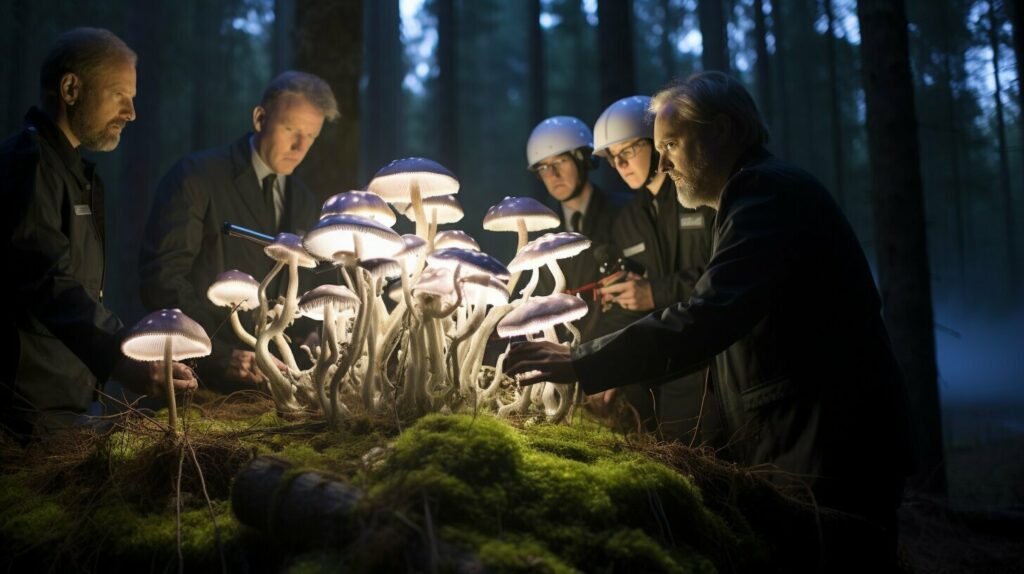
By growing gourmet and medicinal mushrooms at home, you not only enhance your health but also open up a world of extraordinary culinary possibilities, making this a truly enriching and fulfilling hobby. The comprehensive guide, “Growing Gourmet & Medicinal Mushrooms” by Paul Stamets, is your key to unlocking the full potential of mushroom cultivation.
This comprehensive guide provides precise growth parameters for thirty-one different mushroom species, ensuring that you have all the knowledge you need to successfully cultivate a wide variety of mushrooms. From oyster mushrooms to shiitake and lion’s mane, this guide covers it all. Plus, with gardening tips specifically tailored to mushroom cultivation, you’ll learn how to create the perfect growing environment and maintain optimal moisture levels, ensuring the best possible yields.
But it doesn’t stop there. The book also delves into state-of-the-art production techniques that can further enhance the productivity and quality of your mushroom cultivation. With valuable advice on constructing a suitable laboratory and growing room, you’ll have all the tools you need to take your mushroom cultivation to the next level.
Once you’ve harvested your gourmet mushrooms, get ready to embark on a culinary adventure. This guide offers a variety of mouthwatering mushroom recipes and culinary delights that showcase the versatility and flavors of these incredible fungi. From savory stir-fries to delectable soups and hearty pasta dishes, your taste buds will be in for a treat.
So, why not embrace the world of gourmet and medicinal mushrooms? With the guidance of Paul Stamets, a leading expert in mycology, and the comprehensive insights from Fungi Perfecti, you have everything you need to dive into this fascinating and rewarding hobby. Start your journey today and discover the incredible health benefits and culinary wonders that await you.
FAQ
Q: What is “Growing Gourmet & Medicinal Mushrooms” about?
A: “Growing Gourmet & Medicinal Mushrooms” is a comprehensive guide that provides precise growth parameters for thirty-one mushroom species, gardening tips, production techniques, advice for laboratory and growing room construction, mushroom recipes, and a troubleshooting guide. It is a valuable resource for anyone interested in growing and using gourmet and medicinal mushrooms.
Q: Who is the author of “Growing Gourmet & Medicinal Mushrooms”?
A: The book is written by Paul Stamets, a leading expert in mycology and the founder of Fungi Perfecti. He has published two mycology textbooks and is a sought-after lecturer on the subject.
Q: How many photographs, illustrations, and charts are there in the book?
A: The book contains over 500 photographs, illustrations, and charts to help identify each stage of cultivation and provide visual guidance.
Q: Does the book cover a wide range of mushroom species?
A: Yes, the book provides precise growth parameters for thirty-one mushroom species, ensuring that readers have comprehensive information for cultivating a variety of gourmet and medicinal mushrooms.
Q: Does the book offer any troubleshooting tips?
A: Yes, “Growing Gourmet & Medicinal Mushrooms” includes a troubleshooting guide that helps readers identify and overcome common challenges in mushroom cultivation. It offers solutions and prevention strategies for various issues that may arise.
Q: Can the book be useful for beginners in mushroom cultivation?
A: Absolutely! “Growing Gourmet & Medicinal Mushrooms” covers all aspects of mushroom cultivation, including gardening tips, production techniques, and advice for construction. It provides a comprehensive foundation for beginners and serves as a valuable reference for experienced growers as well.

